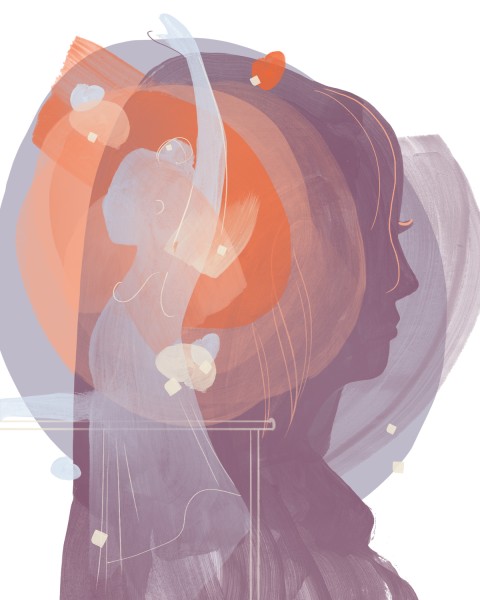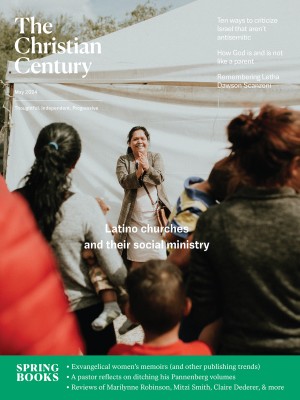Movement of the soul
Justin Peck’s choreography takes the language of ballet and turns it into something more.

(Illustration by Mary Haasdyk Vooys)
I was a ballet dancer for about ten years, from age 5 to 15, when my feet rebelled against the strictures of pointe shoes and I had to give it up. I wasn’t ever particularly serious about it—I didn’t want to take more than two classes a week; no ballet teacher ever said I had it, whatever indefinable thing makes a ballerina a ballerina; and I certainly am not genetically predisposed toward the tall, willowy slimness of a Balanchine girl. This isn’t one of the great losses or regrets of my life; I don’t think that I was ever well suited for the life of discipline that ballet demands. But there are ways that I still carry it with me in my body.
It’s been more than 15 years since my last ballet class, but I still have in my muscles the knowledge of what it means to hit first position at the barre: crown of my head reaching toward the ceiling, shoulders down and back, abdominal muscles tight, tailbone tucked under to lengthen the spine, not just feet but knees and thighs and hips all engaged in maintaining my toes pointed to the corners of the room, hand gently curving to rest on the barre, elbow at a just-so angle. I remember the rigor of it, the strength and lightness all at once.
Read our latest issue or browse back issues.
My mom would take us to ballets—usually the grand romantic storytelling classics. Giselle, dancing to her death with her long hair falling around her. Odette, the princess cursed to become a snow-white swan, dancing her death after being betrayed. Sleeping Beauty, awakening to true love’s kiss and a precise, gorgeous pas de deux with her prince. I watched the same motions and shapes I practiced in front of the mirrors turn into something full of meaning and story. Ballet was all that was romance and tragedy and loss, the stylized beats of a fairy tale turned into stylized movements on a stage.
And then I discovered Justin Peck. He’s a choreographer for the New York City Ballet, but you might have seen his work in the recent West Side Story remake or in one of the music videos or ads he’s done. His ballets are often accompanied by the music of Sufjan Stevens or Dan Deacon or the Dessner brothers—artists more associated with sticky-floored concert venues than the silk and tulle of a ballet stage. He takes their work and the language of ballet—the pointed toes, the positions of the feet and hands, the steps named in French—and turns it into something that somehow feels like just the way your body might move, given elation, given joy, given a certain kind of weightlessness. Perhaps then, not how your body might move, but your soul.
For example, there’s a pas de deux in one of his ballets, The Times Are Racing, that feels for all the world like a perfect first date. Saucy hips and flirtatious sneaker taps, sudden little moments of vulnerability when everything else stops and the two dancers gaze into each other’s eyes, whirling lifts like your stomach full of butterflies when your hands brush against each other for the first time. Even though the ballet the duet appears in doesn’t have much of a narrative arc, you just know: this is a first date, it’s a good first date, and I know it because somewhere inside of me, on the night I met my husband, was a ballerina in sneakers whirling through the air.
I’m someone who generally deals in words. I’m a writer, yes, but it also feels important to me to be able to put language to whatever it is that I’m feeling, to be able to categorize and name and describe thoughts as they pass through my mind, to cover things over with a sheen of language and in so doing, fit them more fully into what I can see and understand of the world. Dance, particularly Justin Peck’s creations, feels like it lives somewhere beyond that: relationships condensed into evolving pas de deux, emotion drawn out into the lines of the body. Despite years of training, I don’t understand the intricacies of how a dance like this is made, what kind of work it takes for a ballet dancer to be able to flick a finger just so. I am unable, for all my wordiness, to describe it with any clear precision, to put the right words around the feelings it gives me.
As a child, I learned the vocabulary of dance: I put words to gestures, pulled gestures and movements together into sequences like beads on a string, felt in my body the way that a rond de jambe might be performed into a feeling of longing or loss, a jeté into joyful exuberance. Ballet teaches you, for better or worse, to have a kind of sense of your body and what it looks like moving through space, and it gives you a formalized set of movements to repeat, over and over, like the Karate Kid, until you realize that something like an elevé or a plié is woven into your body, and then you are able to weave that body into a dance that looks as easy as breathing.
There is something about that vocabulary that I find myself wanting to access again, particularly when it’s imbued not with a desire to dazzle by technical ability or to preserve the courtly rituals of history but to tell us something about what it means to be alive, to be embodied, to be in relation to one another. Something that goes beyond the words we might fit to those feelings and instead just shows them, in all their dazzling grace.





